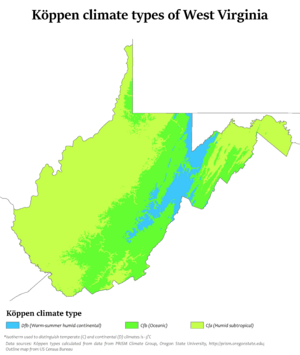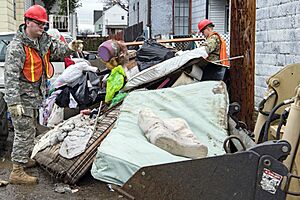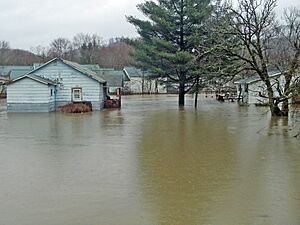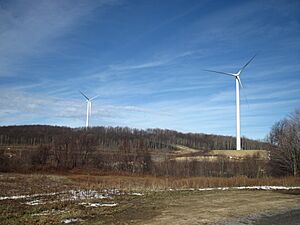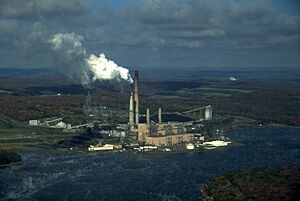Climate change in West Virginia facts for kids
Climate change in West Virginia is a big topic. Over the last 100 years, most of West Virginia has gotten warmer. The temperature has gone up about half a degree to one degree Fahrenheit. Also, heavy rainstorms are happening more often.
In the future, a changing climate will likely cause more floods. It could also hurt natural areas and animals. Some health problems might increase, and fun outdoor activities could be affected. For example, the average temperature in Charleston, West Virginia, has risen about 1.1 degrees Fahrenheit. Rain has also increased by up to 10% in many parts of the state.
Scientists expect even more changes in West Virginia's climate this century. Experts like the Intergovernmental Panel on Climate Change (IPCC) study these changes. Their models suggest that by the year 2100, winter, spring, and summer temperatures could rise by about 3 degrees Fahrenheit. Fall temperatures might go up by 4 degrees Fahrenheit. Rain is also expected to increase by about 20% in all seasons. This means more very hot days in summer. It's not clear how strong storms will be, but summer thunderstorms might become more frequent and intense.
Contents
How Climate Change Affects West Virginia
Water and Flooding
West Virginia has many mountains and hills. Its rivers often get water from melting snow in winter and spring. A warmer climate means snow will melt earlier. This would cause rivers to have more water in winter and spring.
However, in summer and fall, rivers and lakes might have less water. This could make it harder to get enough clean water. It could also affect fun activities like whitewater rafting. Less water in rivers and warmer temperatures can also make pollution worse. This is a problem for areas with acid drainage from coal mines. It also affects places with pollution from factories along the Ohio and Kanawha rivers.
More rain could help with water levels. But too much rain can cause more flooding. Many homes and businesses in West Virginia are in narrow valleys. These areas are easily flooded. More rain can also cause more soil to wash away. This can spread pollution from mining and factories.
A report from 2023, the Fifth National Climate Assessment, noted this problem. It said that states like West Virginia have seen terrible floods from rainstorms.
The 2016 West Virginia Flood
In June 2016, West Virginia had a huge flood. Over 10 inches of rain fell in just 12 to 18 hours. The National Weather Service called it a "once in 1,000 years" event. However, a report from FEMA in 2018 suggested these big floods might happen more often.
A scientist from West Virginia University agrees with this idea. They said it's important to talk honestly about climate change. This will help West Virginia get ready for more intense rain.
After the flood, the West Virginia State Resiliency Office was created. Its goal was to help the state recover and prepare.
Farming and Agriculture
Farming in West Virginia is a big business, bringing in about $400 million each year. Most of this money comes from raising animals like cattle and chickens. Hay is the main crop grown in the state.
Climate change could actually help hay grow more, maybe by 30%. This might change how much land farmers use. Raising livestock like cattle and dairy animals might not be affected much. But if summers get much hotter and drier, animals could gain less weight. Pastures might also not grow as well, meaning less food for animals.
Forests and Trees

West Virginia's forests might change a little or shrink by 5-10% due to climate change. But the types of trees in these forests will likely change a lot. Forests could have more pine trees and scrub oaks. These might replace many of the hardwood trees common in West Virginia.
In areas with richer soil, southern pine trees could spread more. In areas with poorer soil, which are common in West Virginia, scrub oaks might increase. These oaks are not very valuable for wood. So, the overall look and health of West Virginia's forests could change. Climate change might also make it harder to plant new trees on old mining sites.
Natural Habitats and Animals
West Virginia is almost entirely covered by forests, about 97%. Many of these forests are in high mountain areas. These areas have some of the last red spruce trees. These trees are already hurt by acid rain and could be further stressed by a changing climate.
These forests are home to many animals. This includes the varying hare, red squirrel, and the endangered Virginia northern flying squirrel. It also includes the threatened Cheat Mountain salamander. Animals that live in lower areas might be able to move higher up the mountains if it gets warmer. But animals already at the top have nowhere else to go. If the climate changes too much, these spruce forests could shrink a lot or even disappear.
West Virginia has many caves, over 3,300 limestone caves. It has the fourth highest number of caves in the country. At least eight types of bats use these caves. This includes two endangered bats: the Indiana bat and the Virginia big-eared bat. They use caves to sleep in winter or raise their young in summer. One cave protects over 5,000 Indiana bats each winter. Another has the largest group of hibernating Virginia big-eared bats.
Warmer winter temperatures could make caves warmer. This has been shown to cause more Indiana bats to die. For example, if a cave gets 9 degrees Fahrenheit warmer in winter, bats can lose 42% more body weight. The south branch cave beetle is another endangered animal that lives in caves.
Another special place is the Ice Mountain Preserve. It has small holes at the bottom of a rocky slope. These holes blow out 38-degree Fahrenheit air all year. Because of this cold air, plants that usually grow in cold, northern areas grow here. You can even see ice there well into May. But warmer temperatures are already affecting Ice Mountain. The ice around the vents is disappearing earlier in the year. This could harm the unique plants that live there.


